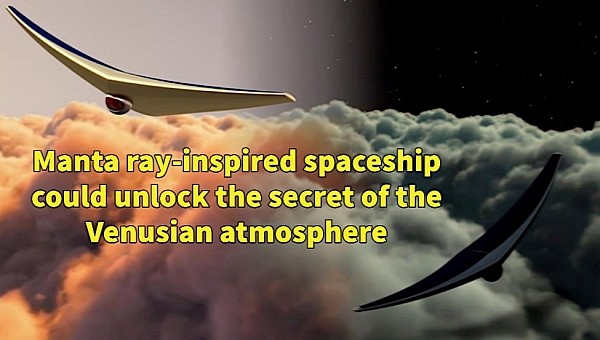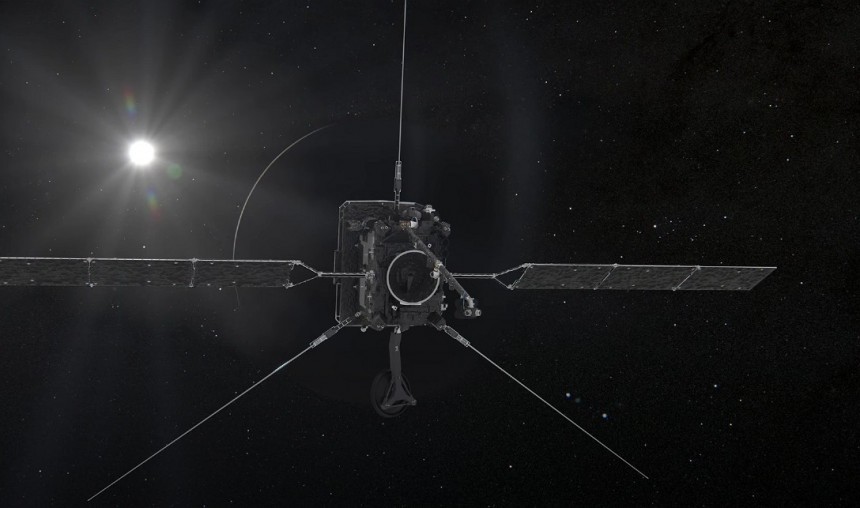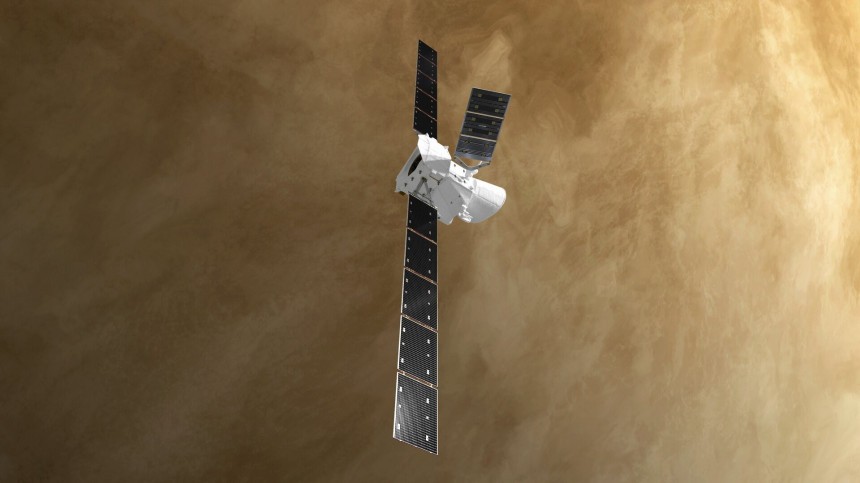Mars is the planet most in the news these days, thanks to our continuous efforts to uncover its secrets. Probably because of that and our hopes for it, some people erroneously call it Earth’s sister planet. But the place is about half the size of our own rock, and its structure is not exactly the same, making it less ideal to be called a proper sibling. Another celestial body in our solar system is however pretty much the same in these respects, and thanks to that it can be considered not only a sister, but a twin to our home world: Venus.
A dead twin, that is, because unlike Earth Venus is now a place that looks utterly inhospitable to life as we know it. It’s got a greenhouse effect so powerful it gets temperatures to values so high (700°F/390°C) they can melt lead, and officially make it the hottest planet in our solar system. Its clouds are made of sulfuric acid, and smell like rotten eggs, while its surface pressure is about 75 times higher than here on Earth, threatening to literally squash everything and everyone that attempts to land there.
For all its inhospitality, though, Venus is considered a place where life could be possible. Those acidic clouds I mentioned earlier could be home to microorganisms, if we are to trust what some scientists are saying. Sci-fi writers sure trust that, and more than one work of literature speaks of the Venusian clouds being populated by bizarre creatures, called in some cases sprites, forever gliding above the deadly surface as they go about their business.
If there are such things up there, then the BREEZE technology might find them. BREEZE is a term that stands for Bioinspired Ray for Extreme Environments and Zonal Exploration and first came up in NASA circles back in 2019, when the agency took note of it for an Innovative Advanced Concepts (NIAC) award.
Described as a technology that blends the idea of inflatable structures with that of propulsion inspired by biology (in this case the musculoskeletal system of a manta ray), it is supposed to be able to glide through the Venusian atmosphere with the goal of giving us a better understanding of what’s going on there.
The BREEZE would launch from Earth in the usual fashion, but together with an orbiter that’s supposed to remain in Venus’ higher orbit and allow the descending hardware continuous communication with Earth.
BREEZE itself would descend to an altitude of between 50 and 60 km (31 to 37 miles), finding winds to ride from place to place. It’s kind of what Earth’s balloons presently do, only unlike them this spacecraft will have the ability, thanks to a series of internally-placed actuators, to change the shape of its wing and move pretty much in any direction at will.
This capability will allow it not only to head over to areas of interest, but also do repeated surveys of a single area. It should go around the planet once every four to six days, allowing for continuous monitoring of this fascinating ball of rock.
A large number of instruments would be included in the BREEZE, including a nephelometer (meant to measure the density of scattered light), an anemometer to measure wind speed and pressure, and a magnetometer. A radar system and visible light camera will also be on board to help with navigation locally, while its altitude and position within the atmosphere will be determined by means of a star tracker, accelerometer, and gyroscope.
BREEZE is not meant to search specifically for signs of life, but you never know what it may come across. Its main mission, if it ever becomes a reality, is to look at things up there and collect samples to be analyzed internally. Determining weather patterns, the composition of the atmosphere, and scanning the hidden surface of the planet are also on the agenda.
The BREEZE spacecraft was proposed by University at Buffalo’s Crash Lab in 2019, and in 2022 it was awarded a Phase I NIAC grant as a proposal by Javid Bayandor from the State University of New York. It’s unclear what stage the project is at the time of writing, if any, but a year ago plans were fairly advanced.
The people behind the idea spoke back then about conducting “preliminary computational studies on the structure, aerodynamics, stability, and inflation” of the technology, and dreamed of moving to scale experiments.
If successful (and there’s no guarantee of that), the project might spawn a new breed of planetary explorers, specially tailored for celestial bodies with a certain atmospheric density. Targets other than Venus announced in 2022 included Saturn’s Moon Titan and even our dear ol' Earth.
More importantly, the atmospheric BREEZE could also spawn a range of robots meant to study liquid environments, and that’s extremely important, given the general consensus that if we are to ever find alien life somewhere in our solar system, water worlds are our best bet. And there is plenty of those right next door: Europa (believed to have twice as much water as Earth), Callisto, Ganymede, or Enceladus, just to name a few.
For all its inhospitality, though, Venus is considered a place where life could be possible. Those acidic clouds I mentioned earlier could be home to microorganisms, if we are to trust what some scientists are saying. Sci-fi writers sure trust that, and more than one work of literature speaks of the Venusian clouds being populated by bizarre creatures, called in some cases sprites, forever gliding above the deadly surface as they go about their business.
If there are such things up there, then the BREEZE technology might find them. BREEZE is a term that stands for Bioinspired Ray for Extreme Environments and Zonal Exploration and first came up in NASA circles back in 2019, when the agency took note of it for an Innovative Advanced Concepts (NIAC) award.
Described as a technology that blends the idea of inflatable structures with that of propulsion inspired by biology (in this case the musculoskeletal system of a manta ray), it is supposed to be able to glide through the Venusian atmosphere with the goal of giving us a better understanding of what’s going on there.
BREEZE itself would descend to an altitude of between 50 and 60 km (31 to 37 miles), finding winds to ride from place to place. It’s kind of what Earth’s balloons presently do, only unlike them this spacecraft will have the ability, thanks to a series of internally-placed actuators, to change the shape of its wing and move pretty much in any direction at will.
This capability will allow it not only to head over to areas of interest, but also do repeated surveys of a single area. It should go around the planet once every four to six days, allowing for continuous monitoring of this fascinating ball of rock.
A large number of instruments would be included in the BREEZE, including a nephelometer (meant to measure the density of scattered light), an anemometer to measure wind speed and pressure, and a magnetometer. A radar system and visible light camera will also be on board to help with navigation locally, while its altitude and position within the atmosphere will be determined by means of a star tracker, accelerometer, and gyroscope.
BREEZE is not meant to search specifically for signs of life, but you never know what it may come across. Its main mission, if it ever becomes a reality, is to look at things up there and collect samples to be analyzed internally. Determining weather patterns, the composition of the atmosphere, and scanning the hidden surface of the planet are also on the agenda.
The people behind the idea spoke back then about conducting “preliminary computational studies on the structure, aerodynamics, stability, and inflation” of the technology, and dreamed of moving to scale experiments.
If successful (and there’s no guarantee of that), the project might spawn a new breed of planetary explorers, specially tailored for celestial bodies with a certain atmospheric density. Targets other than Venus announced in 2022 included Saturn’s Moon Titan and even our dear ol' Earth.
More importantly, the atmospheric BREEZE could also spawn a range of robots meant to study liquid environments, and that’s extremely important, given the general consensus that if we are to ever find alien life somewhere in our solar system, water worlds are our best bet. And there is plenty of those right next door: Europa (believed to have twice as much water as Earth), Callisto, Ganymede, or Enceladus, just to name a few.




